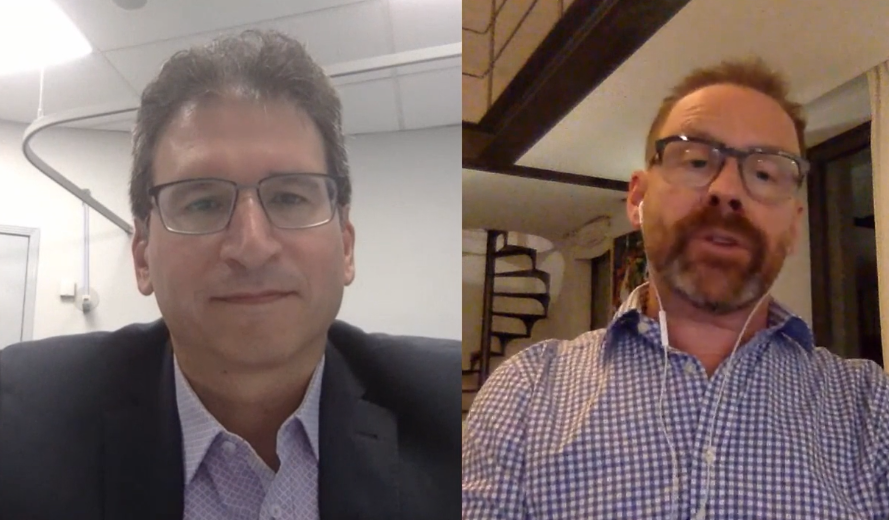
Prof James Lindsay (R) in discussion with AGW session chair Prof Jake Begun (L).
While potential new therapies are in the pipeline for IBD there are also several ways that gastroenterologists can make better use of existing treatment to improve patient outcomes, an international expert told the GESA 2021 virtual meeting.
Patient selection, use of drug combinations and pro-active monitoring were the three key strategies to improve remission rates suggested by Professor James Lindsay, Professor of Inflammatory Bowel Disease at Barts and the London School of Medicine and Dentistry, Queen Mary University of London in his plenary address to GESA’s Australian Gastroenterology IBD session on 5 September.
With patient selection, Prof Lindsay said it was now recognised that early introduction of advanced therapies was associated with better response rates, as has been demonstrated with anti-TNF agents in phase 3 trials.
More recently a significant impact of early introduction of adalimumab or ustekinumab was seen in the results of the SEAVUE trial involving almost 400 treatment naïve patients with CD, he added. Remission rates of up to 65% and mucosal healing rates of 50% were seen at one year, he noted.
And to aid selection of patients who will or will not respond to early biologic treatment it is likely that biomarkers such as CD8+ T cells will have a role, said Prof Lindsay, citing the example of the PROFILE trial whose results are expected imminently.
Clinicians could also use clinical predictors to identify patients who will likely respond best to biologic treatment, he added, noting that criteria such as previous bowel surgery, previous anti-TNF therapy, no prior fistulising disease and baseline CRP had been shown to be associated with responses to vedolizumab in patients with CD.
There are also more specific markers of drug response such as blood TREM-1 levels that predict endoscopic healing with anti-TNF therapy, said Prof Lindsay.
“And there are a range of trials looking at genetic risk scores, gene expression, mucosal biomarkers and metabolomic profiles in predicting response … and I think they will be a key advantage,” he said.
Combining drugs
Using drug combinations to enhance response is another key strategy, according to Professor Lindsay, and will build on approaches such as the use of immunomodulator with anti-TNF therapies to reduce the chances of anti-drug antibodies and thus improving treatment persistence and responses.
“This concept of combination therapy is not novel for us but in terms of combining advanced therapies we are still at the beginning of our journey,” he said.
Prof Lindsay pointed to a recent systematic review of 13 studies of combinations of small molecules and biologics such as tofacitinib and vedolizumab, which had shown that response rates of between 55% to 80% were obtained in patients who had relatively refractory IBD, and without a major increase in adverse events.
“The practice of combination therapy is currently very much in its infancy but I think as the cost of drugs decreases with the increase in use of biosimilars I think we’ll become more familiar with the use of combinations,” he said.
The use of combination therapies will need consideration of concepts such as combining drugs with different mechanisms of action to enhance benefit, use of episodic small molecule therapy to reduce immunogenicity and treat flares, and the use of molecular profiling to select the best combinations and sequences of agents for the individual patient, he suggested.
“One could consider, for example, high dose JAK inhibition as an induction agent followed by an anti-integrin such as vedolizumab to maintain remission,” he said.
Pro-active monitoring
The third and final strategy to improve outcomes with existing agents in IBD is to employ a pro-active approach to monitoring, according to Prof Lindsay.
It doesn’t matter so much which agent you use first so long as we monitor the patient to make sure they respond and then act if they don’t,” he said.
The benefit of this approach had been clearly demonstrated in the REACT trial in which patients treated according to a protocol based on clinical factors were more likely to have therapy escalated earlier compared to those managed by conventional clinical judgement alone.
“Over time, patients treated according to an algorithm in which they were monitored and escalated based on clinical symptoms were significantly less likely to develop disease complications or hospitalisation,” noted Prof Lindsay.
“So simply the act of being pro-active about monitoring improves outcomes.”
He also believed that pro-active monitoring at 14 weeks with near-patient TDM to identify those with low drug levels would help deliver precision dose adjustments and would deliver better outcomes at one year, as shown in the PRECISION trial.
Prof Lindsay said in his practice they were already doing post-induction monitoring, and in response to increased disease activity, as well as an annual check up. This would allow dose adjustment, checking of antibody levels and could also identify patient who may be able to stop therapy, he said
“If they’re in a good clinical and mucosal response and if they’ve got no drug, I’m stopping it. Low drug [levels] is slightly harder because you don’t know if it’s just enough to keep them going or if it’s something else.
“In those kind of settings where it’s not 100% clear if I’m thinking of stopping it I’ll do a baseline fecal calprotectin then I encourage the patients [who are often nervous about stopping] to do another calprotectin two or four weeks after their next dose is due. And that gives them and us the confidence that we will pick up a problem before it arises and [we can] restart treatment,” he said.